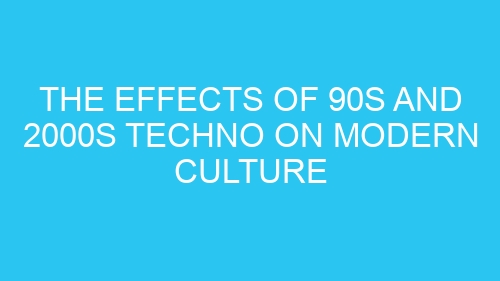-
Table of Contents
The Influence of 90s and 2000s Techno on Contemporary Music Genres
The 90s and 2000s were a time of technological advancement and cultural change. One of the most significant influences of this era was the rise of techno music. Techno, with its pulsating beats and futuristic soundscapes, captured the imagination of a generation and left an indelible mark on contemporary music genres.
Techno music emerged in the 1980s in Detroit, Michigan, as a fusion of electronic dance music and African American musical traditions. It quickly gained popularity in underground clubs and raves, and by the 90s and 2000s, it had become a global phenomenon. The infectious rhythms and hypnotic melodies of techno resonated with young people around the world, and its influence can still be felt in today’s music.
One of the ways in which 90s and 2000s techno has shaped contemporary music genres is through its use of electronic instruments and production techniques. Techno pioneers like Juan Atkins and Derrick May embraced the possibilities of synthesizers, drum machines, and samplers, creating a sound that was both futuristic and otherworldly. This emphasis on electronic instrumentation has since become a hallmark of many modern music genres, from EDM to pop.
Another way in which techno has influenced contemporary music is through its emphasis on rhythm and groove. Techno tracks are characterized by their driving beats and repetitive patterns, which create a sense of momentum and energy on the dancefloor. This focus on rhythm has permeated many genres, from hip-hop to house music, and has become a defining feature of modern popular music.
But perhaps the most significant impact of 90s and 2000s techno on contemporary music genres is its spirit of experimentation and innovation. Techno artists were not afraid to push boundaries and explore new sonic territories, often incorporating unconventional sounds and textures into their music. This spirit of exploration has since been embraced by artists across genres, from experimental rock to avant-garde pop, and has led to the creation of some truly groundbreaking music.
Of course, not all of the effects of 90s and 2000s techno on modern culture have been positive. The rise of electronic dance music has led to an over-saturation of the market, with countless DJs and producers vying for attention. This has resulted in a homogenization of sound, with many tracks sounding formulaic and uninspired. However, there are still artists who are pushing the boundaries of electronic music and finding new ways to innovate and surprise their audiences.
In conclusion, the influence of 90s and 2000s techno on contemporary music genres cannot be overstated. From its use of electronic instruments and production techniques to its emphasis on rhythm and groove, techno has left an indelible mark on modern popular music. Its spirit of experimentation and innovation continues to inspire artists across genres, and its legacy can be heard in the music of today. So the next time you find yourself dancing to a pulsating beat or getting lost in a hypnotic melody, remember that you have the techno pioneers of the 90s and 2000s to thank for it.
The Evolution of Rave Culture: From the 90s and 2000s to Today
The 90s and 2000s were a time of neon colors, baggy pants, and of course, techno music. This genre of electronic dance music took the world by storm and had a profound impact on modern culture. From the evolution of rave culture to the influence on fashion and technology, the effects of 90s and 2000s techno are still felt today.
Let’s take a trip down memory lane and explore how rave culture has evolved over the years. In the 90s, raves were all the rage. People would gather in abandoned warehouses or open fields, dancing the night away to the pulsating beats of techno music. It was a time of freedom and self-expression, where everyone could let loose and be themselves. Fast forward to the 2000s, and raves became more mainstream. They moved from underground venues to massive arenas, attracting thousands of party-goers. The music became more commercialized, but the spirit of unity and euphoria remained.
But what about the impact of 90s and 2000s techno on fashion? Well, let’s just say it was a wild ride. The fashion trends of this era were as bold and vibrant as the music itself. Think neon colors, oversized t-shirts, and those iconic UFO pants. People would accessorize with glow sticks, furry boots, and anything that would make them stand out in a crowd. It was a time of self-expression through fashion, where individuality was celebrated. And while some of these trends may seem outrageous now, they were a reflection of the carefree and rebellious spirit of the time.
Techno music didn’t just influence fashion; it also had a significant impact on technology. The rise of electronic dance music led to advancements in sound systems and DJ equipment. DJs became the rock stars of the electronic music scene, using cutting-edge technology to create mind-blowing sets. The introduction of digital music production software revolutionized the way music was made, allowing anyone with a computer to become a bedroom producer. This democratization of music production paved the way for a new generation of artists and further pushed the boundaries of what was possible in electronic music.
Now, let’s fast forward to today and see how the effects of 90s and 2000s techno are still present in modern culture. While the rave scene may have evolved, the spirit of unity and self-expression remains. Festivals like Coachella and Tomorrowland attract millions of music lovers from around the world, all seeking that same sense of euphoria and connection. The fashion trends may have changed, but the desire to stand out and express oneself through clothing is still prevalent. And technology continues to play a crucial role in the music industry, with DJs and producers constantly pushing the boundaries of what is possible.
In conclusion, the effects of 90s and 2000s techno on modern culture are undeniable. From the evolution of rave culture to the influence on fashion and technology, this genre of music has left a lasting impact. So next time you find yourself dancing to the pulsating beats of electronic music, remember the pioneers of the 90s and 2000s who paved the way for the vibrant and diverse culture we have today. Keep on raving, my friends!
Techno Fashion: How 90s and 2000s Trends Still Impact Modern Style
Techno Fashion: How 90s and 2000s Trends Still Impact Modern Style
Picture this: it’s the 90s, and you’re at a rave, surrounded by people in neon-colored clothing, oversized pants, and futuristic accessories. Fast forward to the 2000s, and you’re at a club, dancing to the pulsating beats of techno, wearing metallic fabrics and chunky platform shoes. Now, take a look around you. You might be surprised to see that these iconic fashion trends from the 90s and 2000s are still influencing modern style today. Let’s dive into the world of techno fashion and explore how these trends have stood the test of time.
One of the most notable aspects of 90s and 2000s techno fashion is its bold and vibrant color palette. Neon greens, electric blues, and hot pinks were all the rage back then, and they continue to make a statement in modern fashion. Whether it’s a neon crop top or a pair of fluorescent sneakers, these eye-catching colors add a touch of nostalgia to any outfit. So, don’t be afraid to embrace your inner 90s kid and rock those neon hues with pride!
Another trend that has made a comeback from the 90s and 2000s is the obsession with futuristic accessories. Remember those chunky plastic bracelets and chokers that glowed in the dark? Well, they’re back and better than ever. Nowadays, you can find futuristic-inspired jewelry made from sleek metals and adorned with LED lights. These accessories not only add a touch of edginess to your outfit but also pay homage to the techno culture that defined the 90s and 2000s.
Of course, we can’t talk about techno fashion without mentioning the iconic oversized pants. Baggy jeans and cargo pants were all the rage back then, and they’re making a comeback in a big way. From wide-leg trousers to oversized joggers, these pants are not only comfortable but also exude a cool and laid-back vibe. Pair them with a crop top or a fitted t-shirt, and you’ve got yourself a modern take on the 90s and 2000s techno fashion.
But let’s not forget about the shoes. In the 90s and 2000s, platform shoes were the epitome of cool. Whether they were chunky sneakers or towering boots, these shoes added height and attitude to any outfit. And guess what? They’re back in style! Platform sneakers are all the rage right now, and they’re the perfect way to add a touch of nostalgia to your modern wardrobe. So, lace up those chunky shoes and get ready to dance the night away.
In conclusion, the effects of 90s and 2000s techno on modern culture are undeniable, especially when it comes to fashion. From the bold and vibrant color palette to the futuristic accessories, these trends continue to influence and inspire modern style. So, the next time you’re getting dressed, don’t be afraid to channel your inner 90s and 2000s techno kid. Embrace the neon colors, rock those oversized pants, and strut your stuff in those platform shoes. After all, fashion is all about expressing yourself and having fun, and what better way to do that than by paying homage to the iconic techno fashion of the past?

